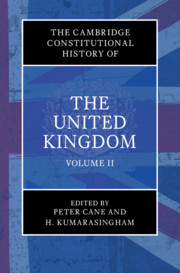Book contents
- The Cambridge Constitutional History of the United Kingdom
- The Cambridge Constitutional History of the United Kingdom
- Copyright page
- Contents
- Contributors
- Editors’ Preface
- 1 The Kingdoms of Anglo-Saxon England (450–1066)
- 2 England after the Conquest
- 3 England in the Thirteenth Century
- 4 England in the Fourteenth Century
- 5 England in the Fifteenth Century
- 6 England in the Sixteenth Century
- 7 The English Constitution in the Seventeenth Century
- 8 A European Perspective
- 9 Wales before Annexation
- 10 The Scottish Constitution before 1707
- 11 The Eighteenth-Century Constitution
- 12 The Constitutional and Parliamentary History of Ireland till the Union
- 13 The United Kingdom in the Nineteenth Century
- 14 The United Kingdom in the Twentieth Century
- 15 The Twenty-First-Century Constitution
- 16 Wales since the Annexation
- 17 Scotland in the Union
- 18 Ireland in the Union
- 19 The Making of Empire
- 20 Constitution and Empire
- Index
3 - England in the Thirteenth Century
Published online by Cambridge University Press: 12 August 2023
- The Cambridge Constitutional History of the United Kingdom
- The Cambridge Constitutional History of the United Kingdom
- Copyright page
- Contents
- Contributors
- Editors’ Preface
- 1 The Kingdoms of Anglo-Saxon England (450–1066)
- 2 England after the Conquest
- 3 England in the Thirteenth Century
- 4 England in the Fourteenth Century
- 5 England in the Fifteenth Century
- 6 England in the Sixteenth Century
- 7 The English Constitution in the Seventeenth Century
- 8 A European Perspective
- 9 Wales before Annexation
- 10 The Scottish Constitution before 1707
- 11 The Eighteenth-Century Constitution
- 12 The Constitutional and Parliamentary History of Ireland till the Union
- 13 The United Kingdom in the Nineteenth Century
- 14 The United Kingdom in the Twentieth Century
- 15 The Twenty-First-Century Constitution
- 16 Wales since the Annexation
- 17 Scotland in the Union
- 18 Ireland in the Union
- 19 The Making of Empire
- 20 Constitution and Empire
- Index
Summary
The thirteenth-century kingdom of England was a political, jurisdictional and administrative unit consisting of thirty-nine contiguous counties which the Norman and Angevin kings of England had in large part inherited from their Anglo-Saxon predecessors – although two of those counties (Cheshire and Durham) had by the thirteenth century come to enjoy an enhanced degree of autonomy, which for many, if not all, purposes placed them outside direct royal control. The kings of England also possessed a limited degree of control over the marcher lordships of Wales which had been conquered from native Welsh rulers by ‘English’ lords and constituted a barrier between England and the kingdoms of Wales. The rest of Wales remained under the control of native Welsh rulers until Edward I in successive campaigns in the 1270s and 1280s destroyed the last remaining native princes and their independence. He did not annex the conquered Welsh lands to the kingdom of England or dispossess all the conquered Welsh, but he established a separate principality of Wales in the north and west of Wales under English control and in 1301 the king’s eldest son became ‘prince’ of Wales. Edward also imposed a version of English law and of the English local administrative system on this area through the Statute of Wales of 1284.1
- Type
- Chapter
- Information
- Publisher: Cambridge University PressPrint publication year: 2023



